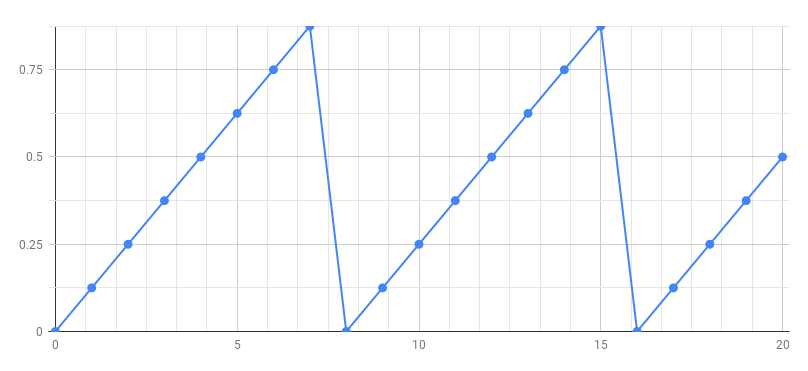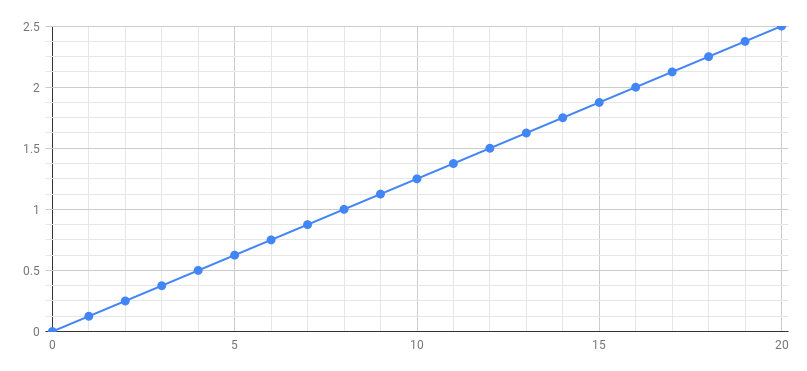Building a Simple MIDI Synthesizer
We are going to build a MIDI synthesizer from scratch (without using the Faust libraries).
Phase Generator
The first step is to build a phase generator that produces a periodic sawtooth signal between 0 and 1. Here is the signal we want to generate:

Ramp
In order to produce the above signal we need first to produce a ramp signal

using the following Faust program:
You can think of a Faust program as a description of an audio circuit
where 0.125, + and _ are primitives of the language (predefined elementary audio components), and the other two signs: : and ~ are used to connect together these audio components.
Semantics
To understand the above diagram let's annotate it with its mathematical semantics.
As we can see in the diagram, the formula of the output signal is:
We can compute the first values of :
- ...
- ...
Phase Signal
How can we transform the above ramp into sawtooth signal ? By removing the integer part of the samples in order to keep only the decimal (fractional) part (3.14159 -> 0.14159).
Let's define a function to do that:
decimalpart(x) = x - int(x);
We can now use that function to transform our ramp into a sawtooth. It is then tempting to write:
process = 0.125 : + ~ _ : decimalpart;
From a mathematical point of view that would be perfectly correct, but we will accumulate rounding errors. To keep full precision it is better to place the decimal part operation inside the loop:
process = 0.125 : (+ : decimalpart) ~ _;
We can now listen the produced signal. Just copy and past decimalpart and process definitions into the Faust Web IDE.
Controlling the Frequency of the Phase Signal
Let's first rearrange our code:
In our phase definition the step value, here 0.125 controls the frequency of the generated signal. We would like to compute this step value according to the desired frequency. In order to do the conversion we need to know the sampling rate. It is available from the standard library as ma.SR.
Let say we would like our phase signal to have a frequency of 1 Hz, then the step should be very small 1/ma.SR so that is will take ma.SR samples (i.e. 1 second) for the phase signal to reach 1.
If we want a frequency of 440 Hz, we need a step 440 times bigger for the phase signal to reach 1 440 times faster.
phase = 440/ma.SR : (+ : decimalpart) ~ _;
We can generalize this definition by replacing 440 by a parameter f:
phase(f) = f/ma.SR : (+ : decimalpart) ~ _;
and by indicating the desired frequency when we use phase:
process = phase(440);
Creating a Sine Wave Oscillator
The next step is to transform above phase generator into a sine wave generator. We will use the sin primitive that computes the sine of x (measured in radians). Therefore we start for the phase signal, we multiply it by 2PI to obtain radiants, and compute the sine. The full program is the following:
Controlling the Frequency and Gain of the Oscillator
The next step is to add some controls on the frequency and gain of the oscillator. We can replace the fixed frequency 440 by a user interface slider:
process = osc(hslider("freq", 440, 20, 10000, 1));
and add a gain to control the output level of the oscillator:
process = osc(hslider("freq", 440, 20, 10000, 1)) * hslider("gain", 0.5, 0, 1, 0.01);
Adding a Gate Button
In order to prepare our MIDI synthesizer we need to add a gate button so that the sound is only when we press it:
process = osc(hslider("freq", 440, 20, 10000, 1)) * hslider("gain", 0.5, 0, 1, 0.01) * button("gate");
Adding an Envelope Generator
It is a good idea to also add an envelop generator. Here we will use a predefined ADSR in the Standard Faust library.
Improving the Timbre
Instead of playing pure sine waves tones, let's improve the timbre with simple additive synthesis:
Running as a Polyphonic MIDI Synth
To control the synthesizer using MIDI you need to use Chrome. The polyphonic MIDI mode is activated using the drop down menu Poly Voices on the left side of the editor. Choose Computer Keyboard as MIDI input to play notes with the computer keyboard, or plug a MIDI keyboard.
Adding a Global Effect
A global effect can be added by providing a definition for effect.
// Common effect
effect = dm.zita_light;
